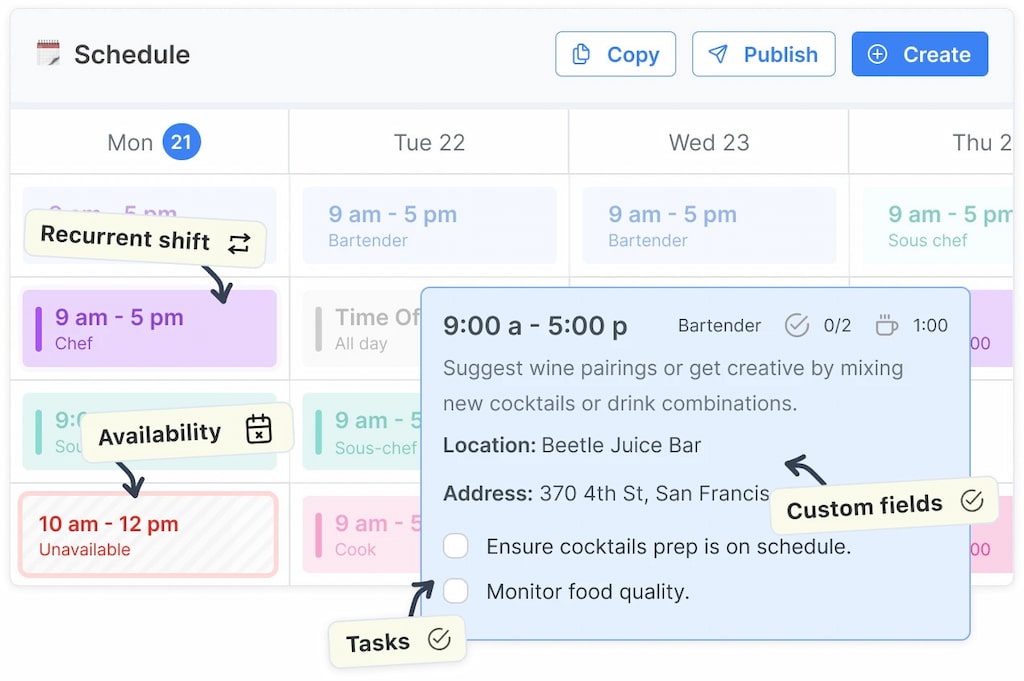Hospital management in 2025 is more complex than ever. From labor shortages and rising patient expectations to fast-moving tech and regulatory changes, hospital managers face constant pressure to adapt quickly and lead with confidence. This guide gives you practical strategies to manage staff, stay compliant, and run operations more efficiently in today’s healthcare environment. Inside, you’ll find:
- Real-world challenges hospitals face in 2025
- 5 essential hospital management tips
- How to prevent burnout—for you and your team
- How tools like Shifts by Everhour modernize scheduling
- Emerging trends in tech and policy
- Key metrics for management success
🚀 Key Takeaways
- 🧠 Strategic vision and frontline awareness must work hand in hand.
- ⚠️ Top challenges: outdated tools, compliance fatigue, poor communication, messy scheduling.
- 🔥 Burnout still hits hard—for nurses, doctors, and managers alike.
- 🛠️ Tech, training, and transparency are no longer optional—they’re expected.
- 🎯 Accountability is the quiet driver behind top-performing systems.
- 🔁 Legacy systems should be phased out with a strategic plan.
- 💙 Empathy + measurable goals = a culture that actually works.
⚡ Common Challenges in Hospital Management
Running a hospital in 2025 means managing staff morale, compliance, patient expectations, and medical scheduling software—all at once. The workload is growing, and the tools to manage it must keep up.
📢 1. Communication breakdown across roles
From surgeons to cleaning staff to remote coders—everyone communicates differently. Miscommunication causes errors, delays, and burnout. A HealthCareIT study found poor internal communication played a role in 70% of serious patient incidents in 2024.
- Use mobile-first communication tools
- Keep conversations traceable across shifts
🔥 2. Burnout is spreading
It’s not just nurses—physicians, managers, and admins are feeling it. In 2025, 53% of hospital staff reported weekly emotional exhaustion. Leaders aren’t immune—1 in 5 considered stepping down.
- Quarterly self-check-ins for leaders
- Peer support rotations
- Early burnout detection training
👩⚕️ 3. Staffing shortages and high churn
Turnover is at record highs—especially among nurses. Scheduling gaps can’t be solved with spreadsheets anymore.
- Use smart scheduling automation
- Partner with medical schools for fresh talent
- Offer flexible shift policies
📋 4. Compliance overload
HIPAA, OSHA, CMS—regulations keep stacking up. Without embedding compliance into everyday workflows, hospitals face fines, licensing risks, and reputational damage.
- Digital compliance dashboards
- Cross-functional policy task forces
🖥 5. Legacy systems still dominate
Outdated tools frustrate staff and block integration. Migrating isn’t easy, but staying outdated costs more. One Ohio hospital saved 4,000+ staff hours annually after switching to a hospital scheduling solution.
💡 Tip #1: Prioritize Burnout Prevention for Staff and Leaders
Burnout isn’t just a buzzword—it’s the biggest threat to hospital stability in 2025.
Actionable tactics:
- 🗓️ Offer mental health days—no red tape or lengthy approvals.
- 🔄 Enable flexible, automated shift swaps (e.g., Shifts by Everhour).
- 👀 Train managers to spot emotional exhaustion, not just absences.
- 📊 Run quarterly pulse surveys to track burnout risk by role.
Don’t forget yourself.
Leaders often push through exhaustion to “stay strong.” But burnout at the top leads to poor decisions. Schedule recovery time like you would a board meeting—and let your team see you doing it. Research shows managers who model work-life balance have healthier, more loyal teams.
💡 Tip #2: Understand—and Evolve With—Patient Expectations
In 2025, patients expect more than treatment—they want a complete care experience.
- ⏱️ Shorter wait times
- 💻 Easy online booking & follow-ups
- 💲 Clear, transparent billing
- 🤝 Human empathy over bureaucracy
- 🔄 Seamless care across digital & in-person visits
Run your hospital like a service brand. Collect NPS or CSAT data, train staff in empathy as well as procedures, and map the patient journey regularly. Use digital kiosks and post-discharge surveys to spot friction points early.
💡 Bonus: Involve frontline nurses in experience reviews—they often see problems before patients speak up.
📊 A 2024 HealthTech survey found 72% of patients would switch providers after just one poor digital or emotional care experience.
💡 Tip #3: Invest in Real Training (Beyond Just Onboarding)
Training in healthcare isn’t a one-time checkbox—it must be ongoing and results-driven.
- 🔄 Continuous: Laws, tech, and procedures change fast.
- 👥 Role-diverse: Everyone—from IT to janitorial staff—needs patient-first fluency.
- 🎯 Outcome-linked: Tie training directly to KPIs and feedback loops.
Plan quarterly training campaigns—not just compliance refreshers. Use LMS tools, mock emergency drills, bedside manner simulations, and real rewards like certification bonuses or extra PTO.
🏥 One top California hospital ran quarterly skill audits with peer-led workshops—readmission rates dropped 18% in a year.
💡 Tip #4: Use technology strategically (not just tactically)
Tech in healthcare isn’t about flashy gadgets—it’s about removing friction and empowering staff.
Where smart tech makes a real difference:
- 📅 Scheduling: Rule-based automation ensures compliance and adequate rest.
- 📲 Communication: Secure mobile updates keep everyone instantly informed.
- 📊 Operations: Real-time dashboards for bed availability, staffing, and bottlenecks.
- 📈 Forecasting: Predict patient volumes using historical analytics.
🔍 Tool spotlight: Shifts by Everhour helps managers forecast staffing needs, automate compliance-aware scheduling, and reduce no-shows with real-time reminders.
🚫 Ditch the spreadsheets. Staff now expect predictive, automated tools—not manual updates that can’t keep pace.
💡 Tip #5: Build systems of accountability (that aren’t punitive)
In healthcare, accountability isn’t top-down micromanagement—it’s about creating systems that clarify and support.
What effective accountability looks like:
- 👀 Visible expectations: Everyone knows the standards and workflows.
- 🤝 Peer-to-peer support: Teams help each other stay on track.
- 🛑 Early issue detection: Catch problems before they escalate.
📋 Use shared dashboards, SOP checklists, and personal goal tracking. These tools aren’t for punishment—they bring clarity and foster trust.
💡 Example: Tracking handoff errors by team can strengthen care transitions without blaming individuals. Transparency beats finger-pointing every time.
📊 Hospitals with strong accountability systems resolve frontline issues 27% faster on average.
🤔 How Hospital Management Has Changed Since COVID
COVID didn’t just stretch hospitals—it rewired how they operate.
❓ What’s different now:
- 💻 Telehealth normalization: Follow-ups via Zoom and online access to test results are now standard patient expectations.
- 📅 Scheduling volatility: Staff want mid-week flexibility. Tools like Shifts by Everhour enable drag-and-drop adaptability.
- 🤝 Cross-functional teams: RNs handling admin, admins managing intake—training must support role fluidity.
- 🧠 Mental health awareness: Silence is risky, dialogue boosts retention. Weekly wellness check-ins are becoming common.
Today’s hospital managers operate more like startup COOs—balancing agility, visibility, and empathy.
👩💻 How to Modernize Your Hospital Ops with Shifts by Everhour
Shifts by Everhour isn’t just a scheduling tool — it’s a complete hospital-ready operations platform.
- ⚙️ Smart templates for rotating and fixed shifts
- ⏰ Compliance alerts for rest rules, overtime limits, and department minimums
- 💬 Integrated communication so everyone stays in the loop
- 🔮 Forecasting tools to predict patient volume by season

❗ Compare this with legacy systems like Excel or manual time clocks — where updates are slow, compliance gets missed, and staff feel disconnected. Hospitals that run lean and flexible will outperform bloated, slow-moving peers. The time to modernize is now.
❓ FAQs: Hospital Management in 2025
What does hospital management actually involve?
It includes overseeing infrastructure, staffing, compliance, technology, and patient outcomes—while maintaining alignment between executive vision and frontline reality.
▶ Discover what a flex shift in a hospital is and how it helps balance staffing needs with employee flexibility.
How can I retain staff in a high-stress hospital setting?
By addressing burnout, improving scheduling fairness, and building a culture of open feedback and team-based support.
What’s the #1 scheduling tool for hospitals in 2025?
Tools like Shifts by Everhour lead the pack due to their automation, compliance integrations, and mobile-first design.
How has patient behavior changed post-COVID?
Patients now expect on-demand access, digital records, more transparent billing, and emotionally intelligent care.
What’s one thing most hospital managers get wrong?
Treating burnout as a personal problem, not a systems issue. Burnout-proofing the workflow is now part of the manager’s job.
How do I transition from legacy systems to modern hospital management tools?
Start by auditing current pain points—scheduling inefficiencies, compliance gaps, and communication silos. Choose a solution like Shifts by Everhour that offers templates, real-time collaboration, and onboarding support to minimize disruption.
How can I measure the performance of my hospital’s management approach?
Use a mix of KPIs: staff turnover rates, patient satisfaction scores, average time to fill shifts, compliance audit results, and burnout survey results. Track monthly and adjust strategy based on trends.
How do we deal with generational differences in the hospital workforce?
Tailor communication, training styles, and incentives. Gen Z prefers mobile tools and feedback loops; Boomers value clarity and consistency. Tech must accommodate both.
What are top hospitals doing differently in 2025?
They’re prioritizing staff well-being, replacing legacy tools with predictive platforms, integrating patient feedback loops, and building agile cross-trained teams.
Want a better way to manage your hospital team, even under pressure?
Try Shifts by Everhour today and see how modern scheduling saves time, retains staff, and improves patient outcomes. It is one of the best free apps for cleaning business, police, pest control, lawn business, and even as fire department scheduling software or security guard scheduling software, and many other industries!
Streamline your team and boost efficiency with the best pest control scheduling software today!
Discover the best home-care scheduling and caregiver apps to simplify your nonprofit’s volunteer management—get started today!

